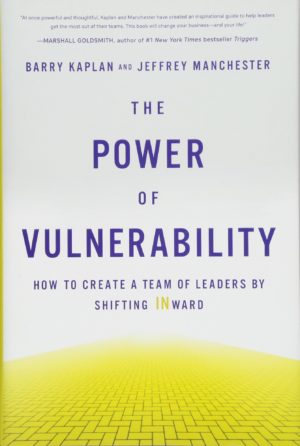Many organizations do not achieve their true potential because they leave much of their power on the table. Organizations often have a culture that prevents people from bringing their full potential to the organization. While an organization could make changes to its strategy, its processes, its structure, or the members of management, one of the most straight-forward changes that can be made to grow in effectiveness is a change in culture.

This is the big idea in the book “The Power of Vulnerability” by Barry Kaplan and Jeffrey Manchester. The book describes the culture of many organizations that makes it unsafe to be authentic in corporate interactions. Since there is not safety in the relationships amongst the leadership team, people spend energy posturing and politicking. They do not feel the connection and freedom in which they can present and explore all of their best ideas. Instead, the members of what should be the leadership team are isolated, attempting to manage their own functional silos, hiding their internal struggles from the rest of the organization and squeezing the most they can from their individual responsibilities.
In fact, it is hard to refer to the top management group in such an organization as a team. They more resemble a functional workgroup, cooperating only to a minimal extent and only when forced. A leadership team should be highly related and reliant upon each other. This book is replete with case studies of organizations that came to the authors’ coaching practice with a fractured team and the process used to build them into a cohesive team.
“As opposed to a functional workgroup, a team is engaged and connected at every level – emotionally, physically, spiritually, and professionally.”
The first step in moving from a group of isolated managers into a team of leaders is to establish a relationship of safety and connection between all of the team members. With such a relationship, the team members can then grow in authenticity, able to share and explore with the team all of their ideas, along with personal struggles and emotions. This relationship also allows team members the setting to quickly short-circuit any interpersonal misunderstandings or struggles that should arise.
“The height of a team’s performance compared to its potential is directly related to the depth of connection among its members.”
The book presents some functional tools for building connection in the team, for effective meetings in a culture of safety and connection, and for interpersonal relationships. By no means is this development of a safe and connected culture an easy process. Rather it takes great effort to first turn around the culture and then a great deal of intentionality to maintain and continually grow this culture over time.
As with any cultural change, the leadership team must first buy in and practice the new culture. Over time this culture, with some encouragement, can grow throughout the organization.
“When the team ‘plays it safe,’ it avoids challenges and misses opportunities. Yet, when the team ‘INpowers’ itself to ‘safely play,’ the team’s authentic communications inspire emergence of enormous capacity.”
The concepts presented in this book are fundamentally about developing a highly effective corporate organization based on the idea of being fully present, fully connected, and fully authentic. Of course, these concepts are the key building blocks for any close relationship, including marriage, parenting, or close friendships. Anyone interested in developing deeper relationship will find it helpful.
Because this book outlines many of the same concepts that I emphasize in my coaching and consulting work, I naturally enjoyed it greatly. It is not a particularly easy read because of the style. It also is clearly written with the idea of gaining coaching clients, as it stops short of presenting the tools that the authors use to develop cultural change. Still I recommend this book.

Add your comment